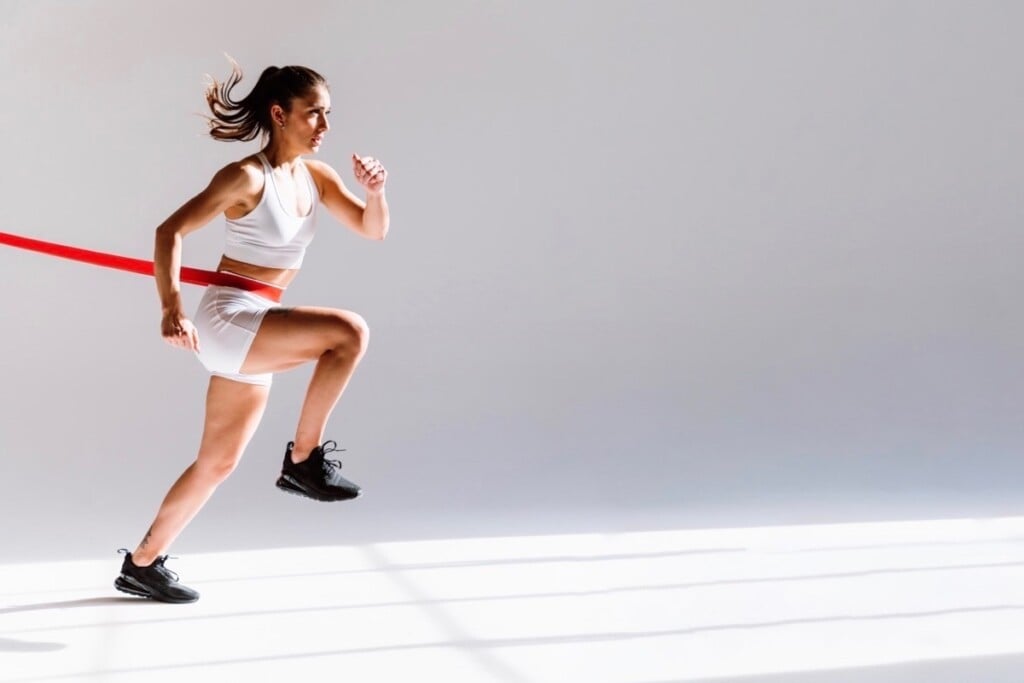The Power Of The Pull
It’s a potent, versatile workout tool that doesn’t require an app: the resistance band.

Leave it to Hollywood and sports A-listers to make a popular new craze out of a simple, low-tech exercise tool that’s been around since the 1800s. Resistance bands trace back to a Swiss inventor who designed a prototype gymnastics apparatus using stretchy ropes with clips and handles. Over the years, the bands have been used by rehabbing patients, gym enthusiasts, home workout fiends—and perhaps the occasional ripped celeb.
Today, basketball uber star LeBron James is known to be “with the band.” When a workout video of him went public in 2013, people saw—between footage of the four-time NBA champion practicing hook shots and three-point jumpers—the way he used resistance bands while performing squats, lunges and other plyometric exercises (that is, those that involve maximum muscle exertion in short bursts of time). More than a decade later, James still reportedly uses resistance-band training as part of his workout regimen, and his physical condition is still apparently pretty good. This past summer, at 39 and the league’s all-time leading scorer, he helped the U.S. men’s basketball team win gold at the Paris Olympics. And he shares the resistance-band habit with actor Jason Momoa, actresses Halle Berry, Jessica Alba and Zendaya and others.
The design of resistance bands has improved over time, as they’ve gone from fabric contraptions to today’s latex-fabric blend, synthetic rubber or silicone. They’re also made with varying levels of tension or resistance, making them ideal for strength training, as they require a person’s force to stretch. (This distinguishes resistance-band training from TRX, total resistance exercises, or suspension training, which uses a person’s own body weight as resistance.) The Cleveland Clinic reports that a 2019 study shows that training with resistance bands provides strength gains similar to those achieved using conventional gym equipment.
“Bands can be very beneficial for beginners, pre- or post-rehab facilitation and seniors,” says Ronnie Lubischer, a certified strength and conditioning specialist. (He owns Lubischer’s Burn and Blast 24 Hour Gyms, with locations in Long Branch and West Long Branch.) With nearly 15 years’ experience in the fitness industry and a degree in exercise science, Lubischer notes that resistance bands can be used to specifically target parts of the body. “They’re also good for very nuanced movements for athletes—think shoulder girdle support for quarterbacks or pitchers,” he says. “Experienced lifters can use them to add ancillary movements to lagging body parts, such as the glutes.”
Lubischer also cites the bands’ rehabilitation potential. “Resistance bands supply a very smooth strength arc through all three phases of your lift—concentric, isometric and eccentric—which makes them perfect for those with tendonitis or arthritic conditions,” he says. “They allow you to work an area without externally loading it, which could be uncomfortable. For beginners and those returning after a long time away from the gym, they are a great way to safely and effectively ramp up your resistance training.”
According to Lubischer, it isn’t hard to pick up a resistance-band workout that will give you the sculpted physique you’ve always wanted. “I like to pair banded chest press with banded rows, as you can quickly transition from one exercise to the next,” he says. “Throw banded biceps curls into the mix, and you get an incredible ‘beach body’ workout quickly with an intense interval.”
Resistance bands aren’t just good for that strength training— they’re good for your health too. As muscles strengthen, blood flow and pressure improve in the body, lowering the risk of heart-related ailments such as hypertension and heart disease, according to the American Council on Exercise (ACE). Lubischer explains: “The bands can provide the stimulus to be both strength- and cardio- based. I give my clients circuits with resistance bands to stimulate muscles and get their hearts pumping in the cardio zone at the same time.” Resistance-band training also will lead to calorie burn and a boosted metabolism, both of which can result in weight loss when combined with an appropriate diet.
Forget pumping iron—let’s stretch some rubber. Below are four quick, easy resistance-band workouts anyone can try at home. “Just like any form of resistance training,” says our expert, “when used in proper form and intensity, these bands can ‘level you up’ to that next phase of your fitness goals.”
• Chest presses: Wrap the resistance band behind your back, holding both ends with your hands. Starting with your arms at your side and elbows bent, push the band out in front of you as you straighten your elbows, and hold for one second.
• Clamshells: Lie on your side, one leg atop the other with your knees slightly bent. Loop a resistance band around both thighs. Keeping your feet together, lift your top knee. Switch sides after each set.
• Rows: Attach the resistance band securely to a door. Holding the band with both hands, pull the band back as you bend your elbows. Keep your elbows near the side of your body.
• Squats: Stand on the resistance band and grab both ends with your hands. While in a squatting position and holding the band, rise up to a standing position. Lower back down and repeat.

